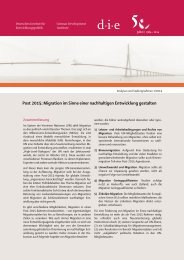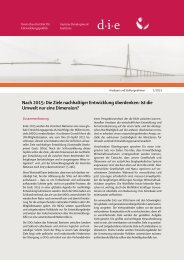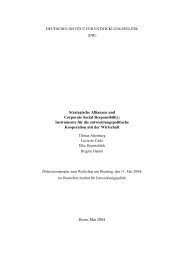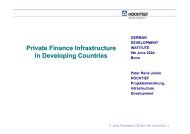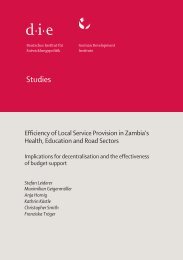Middle East / North Africa and the Millennium Development Goals ...
Middle East / North Africa and the Millennium Development Goals ...
Middle East / North Africa and the Millennium Development Goals ...
You also want an ePaper? Increase the reach of your titles
YUMPU automatically turns print PDFs into web optimized ePapers that Google loves.
Markus Loewe<br />
come poverty <strong>and</strong> hunger. In some countries, poverty has even fur<strong>the</strong>r<br />
spread. Nor has <strong>the</strong>re been sufficient progress on efforts to increase<br />
school-enrolment <strong>and</strong> literacy rates. Many countries of <strong>the</strong> region still lack<br />
modern technologies, <strong>and</strong> all MENA countries are far from reaching <strong>the</strong><br />
goal of environmental sustainability (MDG7) as well as from achieving<br />
<strong>the</strong> goal of good economic <strong>and</strong> political governance (MDG8).<br />
At <strong>the</strong> same time, however, <strong>the</strong> countries of <strong>the</strong> region have made good<br />
progress in implementing MDG3. As in o<strong>the</strong>r regions – excepting sub-<br />
Saharan <strong>Africa</strong> – nearly all MENA countries have succeeded in raising<br />
school enrolment ratios for girls, in this way reducing <strong>the</strong> gap between <strong>the</strong><br />
educational chances of girls <strong>and</strong> boys – although this development has not<br />
yet found expression in improved vocational, political, <strong>and</strong> legal equality<br />
for women in <strong>the</strong> region.<br />
The MENA countries have also made some progress in <strong>the</strong> field of public<br />
health. Many of <strong>the</strong>m have succeeded in appreciably reducing infant,<br />
child, <strong>and</strong> maternal mortality rates, which means that <strong>the</strong>y are likely to<br />
reach MDG4 <strong>and</strong> MDG5. Only for <strong>the</strong> three low-come countries in <strong>the</strong> region,<br />
Mauritania, Sudan, <strong>and</strong> Yemen, are <strong>the</strong>re reasons to fear that <strong>the</strong>se<br />
two goals may not be reached by 2015.<br />
At present not much can be said about MDG6, since <strong>the</strong>re are no reliable<br />
data available on <strong>the</strong> number of persons who have been infected or have<br />
come down with HIV/Aids. One reason for this is that a taboo continues to<br />
hang over this immune-deficiency disease. All in all, <strong>the</strong> prevalence of<br />
HIV/Aids is likely to be lower than in o<strong>the</strong>r parts of <strong>the</strong> world, but <strong>the</strong><br />
number of new infections has risen considerably during <strong>the</strong> last few years.<br />
One country in <strong>the</strong> region has proved particularly successful with regard to<br />
<strong>the</strong> MDGs: Tunisia is more than likely to reach at least six of <strong>the</strong> eight<br />
goals. It has encountered some difficulties in implementing MDG5 <strong>and</strong><br />
MDG7 – although its main problem is meeting <strong>the</strong> good-governance target<br />
in MDG8. As far as human rights, freedom of <strong>the</strong> press, <strong>and</strong> <strong>the</strong> participation<br />
of <strong>the</strong> population in political decision-making are concerned, <strong>the</strong><br />
situation in Tunisia has even deteriorated since 1990.<br />
42 German <strong>Development</strong> Institute



